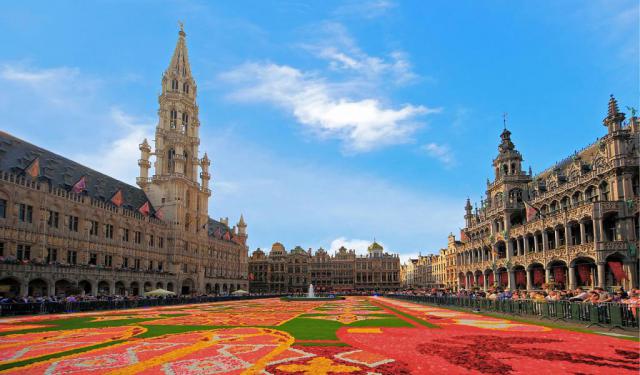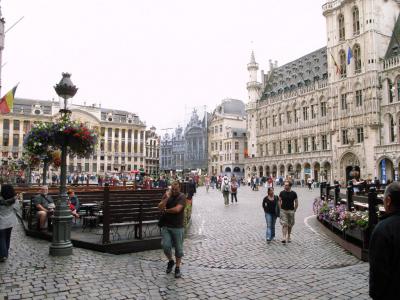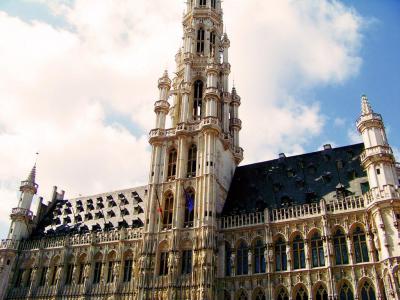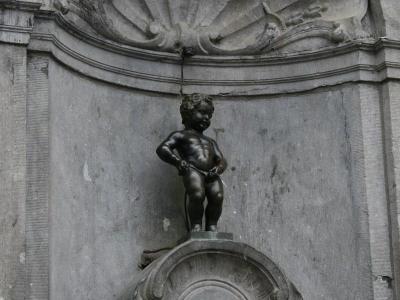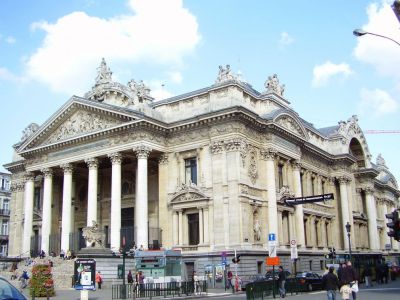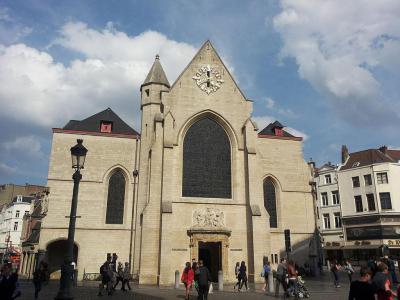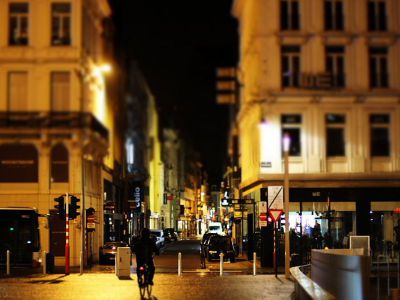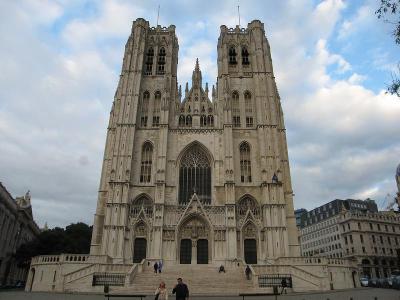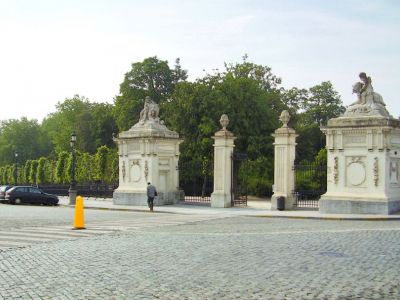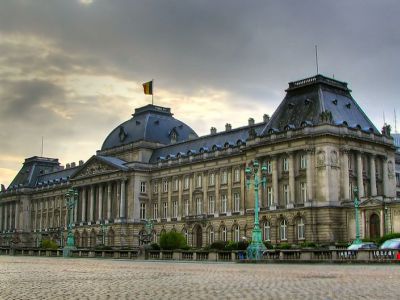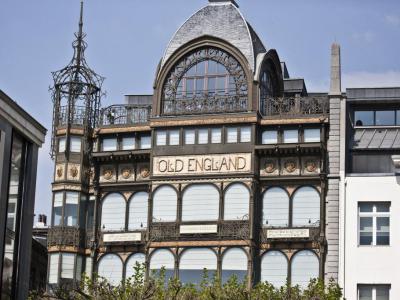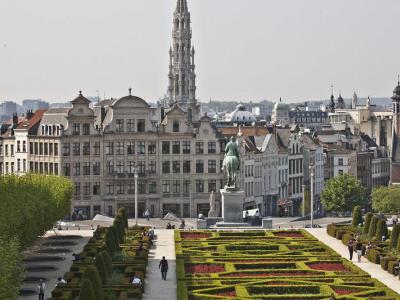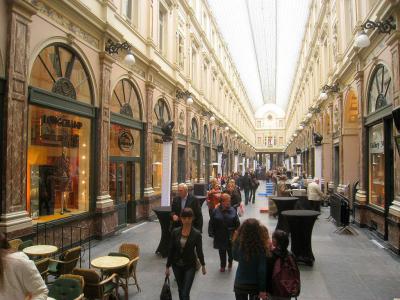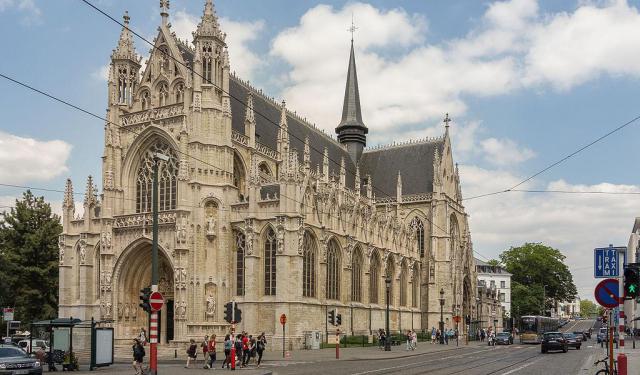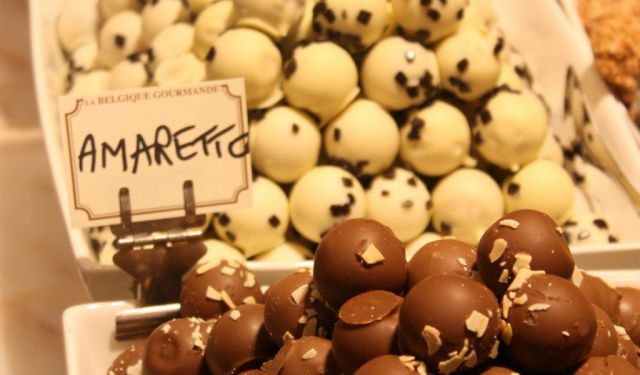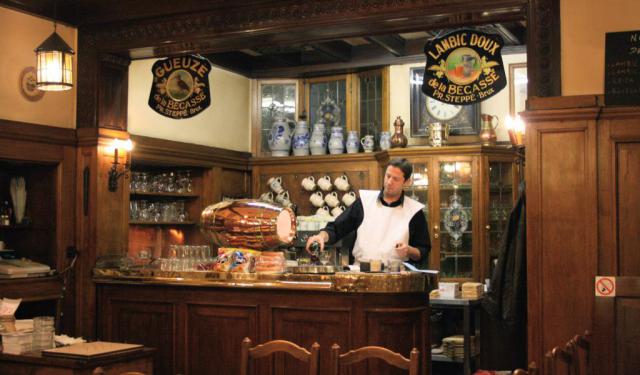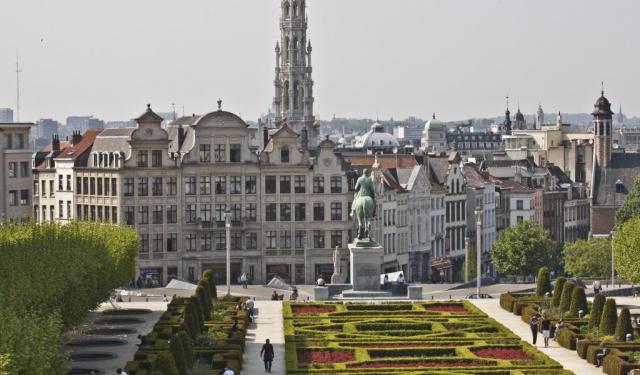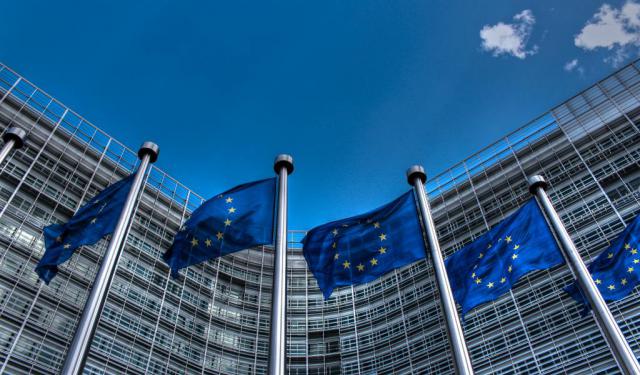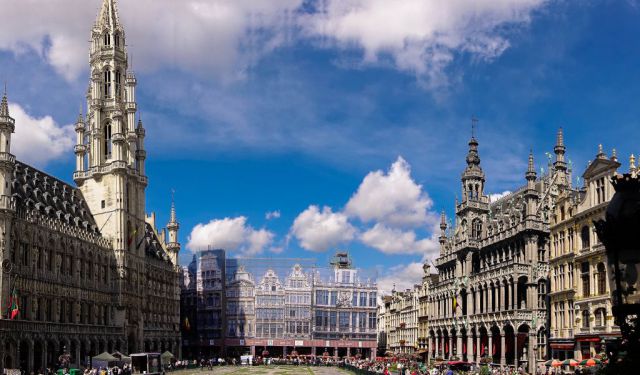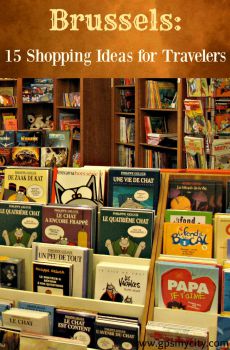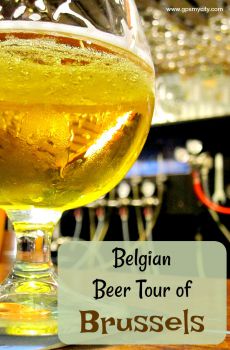Audio Guide: Brussels Introduction Walking Tour (Self Guided), Brussels
Nowadays a major center for international politics, the capital of Belgium, Brussels, is often referred to as the "Crossroads of Europe". Indeed, nestled at the heart of the continent, this city has a history closely linked to that of Western Europe. Repeatedly changing hands between various duchies, empires, republics, and kingdoms, it has evolved from a small rural settlement to an important metro-region.
The name ‘Brussels’ likely finds its roots in the Old Dutch ‘Broeksel’, which means ‘home in the marsh’.
Although originated around 580 AD as a modest chapel on an island in the river Senne, the city's official founding dates back to 979 AD, when Duke Charles transferred Saint Gudula's relics there. Positioned on a major trade route, Brussels flourished as a textile hub and later as a lace industry center in the 17th century. Over the next 200 years, the city was subject to a dispute between France, Spain, and Austria that destroyed a good third of its buildings. After ending foreign rule with Napoleon's defeat, in 1815, followed by the Belgian Revolution of 1830, Brussels became Belgium's capital. Post-WWII, the city modernized significantly and became the de facto capital of the European Union and the NATO.
Despite drastic changes, Brussels still retains its intimate charm, with cobblestone streets and ancient buildings whispering the tales of yesteryears.
A jewel in the crown of its Old Town is the medieval Grand Square. Recognized as a UNESCO World Heritage site, this square is surrounded by opulent guildhalls and the striking Gothic Town Hall. Every two years it blooms into a vibrant spectacle with the famous Flower Carpet event.
Not far away, the cheeky Manneken Pis statue, depicting a little boy mischievously urinating, captures the whimsical spirit of the city.
Spiritual seekers and history enthusiasts will find solace in the towering Gothic masterpiece of Saint Michel and Saint Gudula Cathedral. At the same time, shopping aficionados will relish the elegant Royal Galleries of Saint-Hubert, a glass-roofed arcade filled with luxury shops, quaint cafes, and chocolatiers.
Further enriching Brussels’ cultural landscape are the Musical Instruments Museum and the grand Royal Palace, the official residence of Belgian monarchs, which opens its doors to the public each summer.
As you plan your visit, make sure to carve out plenty of time to explore, experience, and enjoy everything Brussels has to offer. From its historic roots to its modern-day marvels, Brussels welcomes guests with open arms and promises unforgettable adventures. So, why wait? Discover Brussels today, and let your own story unfold in this enchanting metropolis!
The name ‘Brussels’ likely finds its roots in the Old Dutch ‘Broeksel’, which means ‘home in the marsh’.
Although originated around 580 AD as a modest chapel on an island in the river Senne, the city's official founding dates back to 979 AD, when Duke Charles transferred Saint Gudula's relics there. Positioned on a major trade route, Brussels flourished as a textile hub and later as a lace industry center in the 17th century. Over the next 200 years, the city was subject to a dispute between France, Spain, and Austria that destroyed a good third of its buildings. After ending foreign rule with Napoleon's defeat, in 1815, followed by the Belgian Revolution of 1830, Brussels became Belgium's capital. Post-WWII, the city modernized significantly and became the de facto capital of the European Union and the NATO.
Despite drastic changes, Brussels still retains its intimate charm, with cobblestone streets and ancient buildings whispering the tales of yesteryears.
A jewel in the crown of its Old Town is the medieval Grand Square. Recognized as a UNESCO World Heritage site, this square is surrounded by opulent guildhalls and the striking Gothic Town Hall. Every two years it blooms into a vibrant spectacle with the famous Flower Carpet event.
Not far away, the cheeky Manneken Pis statue, depicting a little boy mischievously urinating, captures the whimsical spirit of the city.
Spiritual seekers and history enthusiasts will find solace in the towering Gothic masterpiece of Saint Michel and Saint Gudula Cathedral. At the same time, shopping aficionados will relish the elegant Royal Galleries of Saint-Hubert, a glass-roofed arcade filled with luxury shops, quaint cafes, and chocolatiers.
Further enriching Brussels’ cultural landscape are the Musical Instruments Museum and the grand Royal Palace, the official residence of Belgian monarchs, which opens its doors to the public each summer.
As you plan your visit, make sure to carve out plenty of time to explore, experience, and enjoy everything Brussels has to offer. From its historic roots to its modern-day marvels, Brussels welcomes guests with open arms and promises unforgettable adventures. So, why wait? Discover Brussels today, and let your own story unfold in this enchanting metropolis!
How it works: Download the app "GPSmyCity: Walks in 1K+ Cities" from Apple App Store or Google Play Store to your mobile phone or tablet. The app turns your mobile device into a personal tour guide and its built-in GPS navigation functions guide you from one tour stop to next. The app works offline, so no data plan is needed when traveling abroad.
Brussels Introduction Walking Tour Map
Guide Name: Brussels Introduction Walking Tour
Guide Location: Belgium » Brussels (See other walking tours in Brussels)
Guide Type: Self-guided Walking Tour (Sightseeing)
# of Attractions: 12
Tour Duration: 2 Hour(s)
Travel Distance: 3.6 Km or 2.2 Miles
Author: audrey
Sight(s) Featured in This Guide:
Guide Location: Belgium » Brussels (See other walking tours in Brussels)
Guide Type: Self-guided Walking Tour (Sightseeing)
# of Attractions: 12
Tour Duration: 2 Hour(s)
Travel Distance: 3.6 Km or 2.2 Miles
Author: audrey
Sight(s) Featured in This Guide:
- Grand Place (Grand Square)
- Hotel de Ville (Town Hall)
- Manneken Pis (Little Boy Peeing)
- Bourse de Bruxelles (Stock Exchange Building)
- Eglise Saint-Nicolas (St. Nicholas Church)
- Rue Neuve (New Street)
- Cathedrale des Saints Michel et Gudule (St. Michael and St. Gudula Cathedral)
- Parc de Bruxelles (Brussels Park)
- Palais Royal (Royal Palace)
- Musical Instruments Museum (MIM)
- Mont des Arts (Mount of the Arts)
- Galeries Royales Saint-Hubert (Royal Saint-Hubert Galleries)
1) Grand Place (Grand Square) (must see)
Grand Square-Brussels’ pride and joy-is the biggest show-off move of the Belgian capital. Some say it's the most beautiful square in Europe. Others say the world. Either way, it’s hard to argue when you’re standing there, dwarfed by a 15th-century Gothic Town Hall that looks like it got dressed for the Met Gala... and the neo-Gothic King's House-also charmingly called the Bread House (because apparently even royal buildings get carb cravings).
This cobblestoned stunner has been in the spotlight since the 11th century. Back then, it was a humble marketplace. A few hundred years later, it had a front-row seat to history-picture Inquisition bonfires and a couple of unfortunate noble executions (some sort of “light afternoon entertainment” for the medieval crowd)...
As Brussels bloomed, so did the square’s bling. Surrounding it are guildhalls that practically scream, “We have money and good taste!” Each one was built by a different trade-from haberdashers to bakers to brewers-and while the jobs have changed, the beauty hasn’t. Take Number 10, for example-once a brewers’ headquarters, now home to the Brewers Museum, so yes, beer still lives there. Circle of life.
Now, not everything has been smooth sailing here. In 1695, the French decided Brussels needed a “makeover.” So they bombarded the square for 36 hours straight. Miraculously, several buildings were rebuilt after that even better. Like Number 3, once run by tallow merchants, and Number 5, home of the archers’ guild, proudly rocking a phoenix on its façade-a little "burn me once" statement piece.
Today, in addition to being a history lesson with a stunning backdrop, the Grand Square is a vibe. Alleyways nearby are filled with centuries-old bars serving the holy trinity: Belgian beer, chocolate, and gossip. Butchers Street is your go-to for mussels and souvenirs and maybe some stretchy pants.
And if you time it right, you’ll catch the square in full party mode. There’s the biennial Flower Carpet-a psychedelic begonia explosion, the medieval cosplay of Ommegang, Christmas lights that would make the North Pole jealous, and concerts that echo through time.
Tip:
Visit in daylight to admire every gold-leafed flourish, and come back after dark for the light show. Around 10:20 PM, this square doesn’t just sparkle-it sings.
This cobblestoned stunner has been in the spotlight since the 11th century. Back then, it was a humble marketplace. A few hundred years later, it had a front-row seat to history-picture Inquisition bonfires and a couple of unfortunate noble executions (some sort of “light afternoon entertainment” for the medieval crowd)...
As Brussels bloomed, so did the square’s bling. Surrounding it are guildhalls that practically scream, “We have money and good taste!” Each one was built by a different trade-from haberdashers to bakers to brewers-and while the jobs have changed, the beauty hasn’t. Take Number 10, for example-once a brewers’ headquarters, now home to the Brewers Museum, so yes, beer still lives there. Circle of life.
Now, not everything has been smooth sailing here. In 1695, the French decided Brussels needed a “makeover.” So they bombarded the square for 36 hours straight. Miraculously, several buildings were rebuilt after that even better. Like Number 3, once run by tallow merchants, and Number 5, home of the archers’ guild, proudly rocking a phoenix on its façade-a little "burn me once" statement piece.
Today, in addition to being a history lesson with a stunning backdrop, the Grand Square is a vibe. Alleyways nearby are filled with centuries-old bars serving the holy trinity: Belgian beer, chocolate, and gossip. Butchers Street is your go-to for mussels and souvenirs and maybe some stretchy pants.
And if you time it right, you’ll catch the square in full party mode. There’s the biennial Flower Carpet-a psychedelic begonia explosion, the medieval cosplay of Ommegang, Christmas lights that would make the North Pole jealous, and concerts that echo through time.
Tip:
Visit in daylight to admire every gold-leafed flourish, and come back after dark for the light show. Around 10:20 PM, this square doesn’t just sparkle-it sings.
2) Hotel de Ville (Town Hall) (must see)
The Brussels Town Hall-part municipal headquarters, part medieval masterpiece, and all-around showoff of the Grand Square. Built between 1401 and 1455, this beauty is the only medieval building still standing in the square. Rich in Brabantine Gothic flair, it was declared a protected monument in 1936 and added to UNESCO’s World Heritage Site list in 1998.
Despite its regal look, the building’s had its fair share of drama. In 1695, during the Nine Years' War, the French heavily bombarded the city. The Town Hall took a hit: fire gutted the interior, torched the archives, and turned priceless artworks into ashes. And yet, like a true diva, it survived.
Its present-day form-a tidy quadrilateral wrapped around a central courtyard-dates from the 18th century, when two extra wings were slapped on the back. Then came the 19th century, when restorers went full "Gothic revival" mode and added nearly 300 statues, gargoyles, and fancy flourishes-because subtlety is not the style for this kind of property. Each ornament nods to Brussels’ proud guild traditions and colorful past.
Speaking of drama, notice that the tower isn’t centered? Legend says that the architect, Jan van Ruysbroek, was so distraught over the lopsided design that he threw himself off the tower. Dark... But let’s be real-it was probably just a classic case of medieval planning chaos.
Crowning the 96-meter tower is a golden spire topped with Saint Michael giving a devil the boot. The current statue is a 1990s replica, but the original goes back to 1455. Inside, it’s all chandeliers, frescoes, and enough historic rooms to make your head spin. Check out the Gothic Room, the Prince’s Gallery, the Mayor’s Cabinet, and the crown jewel-the States of Brabant Room, with a ceiling that deserves its own fan club.
Tip:
You can visit the inside, but only with a guided tour-around 45 minutes long and available in French, English, Dutch, or Spanish. Spots are limited and sell out fast, so grab your ticket early in the day. Tours run on Mondays, Wednesdays, Fridays, Saturdays, and Sundays. Just don’t show up on January 1, May 1, November 1 or 11, or December 25-because even grand old Town Halls need a day off.
Despite its regal look, the building’s had its fair share of drama. In 1695, during the Nine Years' War, the French heavily bombarded the city. The Town Hall took a hit: fire gutted the interior, torched the archives, and turned priceless artworks into ashes. And yet, like a true diva, it survived.
Its present-day form-a tidy quadrilateral wrapped around a central courtyard-dates from the 18th century, when two extra wings were slapped on the back. Then came the 19th century, when restorers went full "Gothic revival" mode and added nearly 300 statues, gargoyles, and fancy flourishes-because subtlety is not the style for this kind of property. Each ornament nods to Brussels’ proud guild traditions and colorful past.
Speaking of drama, notice that the tower isn’t centered? Legend says that the architect, Jan van Ruysbroek, was so distraught over the lopsided design that he threw himself off the tower. Dark... But let’s be real-it was probably just a classic case of medieval planning chaos.
Crowning the 96-meter tower is a golden spire topped with Saint Michael giving a devil the boot. The current statue is a 1990s replica, but the original goes back to 1455. Inside, it’s all chandeliers, frescoes, and enough historic rooms to make your head spin. Check out the Gothic Room, the Prince’s Gallery, the Mayor’s Cabinet, and the crown jewel-the States of Brabant Room, with a ceiling that deserves its own fan club.
Tip:
You can visit the inside, but only with a guided tour-around 45 minutes long and available in French, English, Dutch, or Spanish. Spots are limited and sell out fast, so grab your ticket early in the day. Tours run on Mondays, Wednesdays, Fridays, Saturdays, and Sundays. Just don’t show up on January 1, May 1, November 1 or 11, or December 25-because even grand old Town Halls need a day off.
3) Manneken Pis (Little Boy Peeing) (must see)
The small bronze statue of a little boy faithfully relieving himself atop a fountain has paradoxically emerged as an unexpected symbol of Brussels.
The site has been a water fountain since the 13th century, but the statue in its current baroque form was crafted in 1619 to replace an earlier version. Throughout history, the Little Boy Peeing has been stolen and thrown into the canal multiple times. What we see today is a copy made in 1965. The original statue is safeguarded in the Brussels City Museum to protect it from any further mishaps.
This enduring sculpture exemplifies the typical Brussels sense of humor and its capacity to poke fun at its own image. Apart from its humor, however, the statue is renowned for various legends associated with it.
One story claims that it commemorates a brave young boy who urinated on a burning fuse, preventing an explosive charge from detonating and potentially destroying the city's fortification walls. In another account, a wealthy merchant, after an extensive citywide search for his missing son, who was eventually found joyfully urinating in a garden, presented the statue, as a token of his appreciation, to the townspeople who aided in the search. Yet another version of the tale suggests that a young boy woke up to find a fire in the king's castle and promptly used his urine to douse the flames, thus preventing it from burning to the ground.
For about one-third of the year, the statue is dressed up in various costumes by an official dresser who has been appointed by the city since 1755. The current dresser, Nicolas Edelman, is the 13th since the 18th century. In 2014, he volunteered for the job which implies dressing up the statue for about 130 events annually. The role demands flexibility, requiring early mornings or late evenings, regardless of weather or day.
The costumes, donated by various entities, must meet quality standards and not serve political, commercial, or religious agendas. To date, the peeing boy has donned over 500 different outfits, ranging from the earliest-known attire, a Louis XV-provided ensemble portraying him as an elegant 17th-century gentleman, to a samurai robe celebrating the friendship between Belgium and Japan.
Little Boy Peeing has two companion statues: Little Girl Peeing (depicting a urinating girl, installed in 1987 in an alleyway near the Grand Square) and Little Dog Peeing (portraying a urinating dog, erected in 1998 in Dansaert, modeled after a real dog owned by the sculptor). Both of them are located approximately 550 meters away from the Little Boy Peeing but in different directions.
The site has been a water fountain since the 13th century, but the statue in its current baroque form was crafted in 1619 to replace an earlier version. Throughout history, the Little Boy Peeing has been stolen and thrown into the canal multiple times. What we see today is a copy made in 1965. The original statue is safeguarded in the Brussels City Museum to protect it from any further mishaps.
This enduring sculpture exemplifies the typical Brussels sense of humor and its capacity to poke fun at its own image. Apart from its humor, however, the statue is renowned for various legends associated with it.
One story claims that it commemorates a brave young boy who urinated on a burning fuse, preventing an explosive charge from detonating and potentially destroying the city's fortification walls. In another account, a wealthy merchant, after an extensive citywide search for his missing son, who was eventually found joyfully urinating in a garden, presented the statue, as a token of his appreciation, to the townspeople who aided in the search. Yet another version of the tale suggests that a young boy woke up to find a fire in the king's castle and promptly used his urine to douse the flames, thus preventing it from burning to the ground.
For about one-third of the year, the statue is dressed up in various costumes by an official dresser who has been appointed by the city since 1755. The current dresser, Nicolas Edelman, is the 13th since the 18th century. In 2014, he volunteered for the job which implies dressing up the statue for about 130 events annually. The role demands flexibility, requiring early mornings or late evenings, regardless of weather or day.
The costumes, donated by various entities, must meet quality standards and not serve political, commercial, or religious agendas. To date, the peeing boy has donned over 500 different outfits, ranging from the earliest-known attire, a Louis XV-provided ensemble portraying him as an elegant 17th-century gentleman, to a samurai robe celebrating the friendship between Belgium and Japan.
Little Boy Peeing has two companion statues: Little Girl Peeing (depicting a urinating girl, installed in 1987 in an alleyway near the Grand Square) and Little Dog Peeing (portraying a urinating dog, erected in 1998 in Dansaert, modeled after a real dog owned by the sculptor). Both of them are located approximately 550 meters away from the Little Boy Peeing but in different directions.
4) Bourse de Bruxelles (Stock Exchange Building)
Across from the church of Saint Nicholas, you'll find a seamless blend of Neo-Renaissance and Second Empire architecture manifested in the form of the grandiose Stock Exchange building. Known locally as the Bourse, it was built over five years, from 1868 to 1873, as part of the urban beautification project.
The imposing structure boasts detailed ornamentation with an array of allegorical figures representing various professions, like Navigation, and continents – Africa, Asia, etc. The twin lions flanking the main staircase carry a message – one, with its head high, symbolizes the rise of stocks, while the other, with its head lowered, signifies their potential decline. The relief of a female figure represents the City of Brussels; the two figures on her sides symbolize Industry and Trade, whereas the winged statues below symbolize the forces of Good and Evil.
Partially ravaged by fire in 1990, the building has been restored inside and out, and now houses the Brussels branch of the Euronext network, which has also incorporated the Amsterdam and Paris exchanges since 2000. While the Bourse is not open to the public, its exterior remains an impressive sight, with the stairway offering a pleasant vantage point for people-watching or reading.
The surrounding square frequently hosts various exhibitions, activities, and street performances on weekends. The building itself is flanked by two renowned cafés: the Art Nouveau Falstaff, on the south side, at Henri Maus Street, and on the opposite side, at Bourse Street, the end-of-19th-century Le Cirio. In front of the latter, you'll find the glassed-in remains of a medieval church and convent, discovered by archaeologists in the 1980s, now known as Bruxella 1238.
The imposing structure boasts detailed ornamentation with an array of allegorical figures representing various professions, like Navigation, and continents – Africa, Asia, etc. The twin lions flanking the main staircase carry a message – one, with its head high, symbolizes the rise of stocks, while the other, with its head lowered, signifies their potential decline. The relief of a female figure represents the City of Brussels; the two figures on her sides symbolize Industry and Trade, whereas the winged statues below symbolize the forces of Good and Evil.
Partially ravaged by fire in 1990, the building has been restored inside and out, and now houses the Brussels branch of the Euronext network, which has also incorporated the Amsterdam and Paris exchanges since 2000. While the Bourse is not open to the public, its exterior remains an impressive sight, with the stairway offering a pleasant vantage point for people-watching or reading.
The surrounding square frequently hosts various exhibitions, activities, and street performances on weekends. The building itself is flanked by two renowned cafés: the Art Nouveau Falstaff, on the south side, at Henri Maus Street, and on the opposite side, at Bourse Street, the end-of-19th-century Le Cirio. In front of the latter, you'll find the glassed-in remains of a medieval church and convent, discovered by archaeologists in the 1980s, now known as Bruxella 1238.
5) Eglise Saint-Nicolas (St. Nicholas Church)
Dedicated to Saint Nicholas of Bari, the patron saint of sailors (famously known as Santa Claus), this church has a history dating back to the 12th century.
Charming in appearance, the current building has very little left of its original structure. The 14th-century Gothic facade now covers the earlier Romanesque lines. A tall belfry, once present in the Middle Ages as the city's watch tower, is long gone after collapsing unexpectedly in 1714, killing one man and a pig.
The church underwent significant restoration in the 1950s with portions of its exterior reconstructed in a simple Gothic style. One distinctive feature of it is the deliberate orientation of three broad nave aisles built at an angle to the chancel so as to accommodate a nearby stream. An intriguing relic of the past is the cannonball embedded high up in the third pillar on the left side of the nave, a remnant from the French bombardment of 1695.
Inside the church, you can find valuable artworks such as 'The Virgin and Child' painting by the famous Flemish painter Rubens, and the Vladimir Icon from Constantinople dating back to 1131. Among other art pieces is a splendid gilded copper reliquary shrine, in the right-hand aisle, crafted in Germany during the 19th century to honor a group of Catholics martyred by Protestants in Gorinchem, Netherlands, in 1572.
In recent years, there were discussions about demolishing this historic church to make way for vehicular traffic. Fortunately, none of these plans came to fruition, and it remains preserved, much like the charming ancient architecture that surrounds it.
Charming in appearance, the current building has very little left of its original structure. The 14th-century Gothic facade now covers the earlier Romanesque lines. A tall belfry, once present in the Middle Ages as the city's watch tower, is long gone after collapsing unexpectedly in 1714, killing one man and a pig.
The church underwent significant restoration in the 1950s with portions of its exterior reconstructed in a simple Gothic style. One distinctive feature of it is the deliberate orientation of three broad nave aisles built at an angle to the chancel so as to accommodate a nearby stream. An intriguing relic of the past is the cannonball embedded high up in the third pillar on the left side of the nave, a remnant from the French bombardment of 1695.
Inside the church, you can find valuable artworks such as 'The Virgin and Child' painting by the famous Flemish painter Rubens, and the Vladimir Icon from Constantinople dating back to 1131. Among other art pieces is a splendid gilded copper reliquary shrine, in the right-hand aisle, crafted in Germany during the 19th century to honor a group of Catholics martyred by Protestants in Gorinchem, Netherlands, in 1572.
In recent years, there were discussions about demolishing this historic church to make way for vehicular traffic. Fortunately, none of these plans came to fruition, and it remains preserved, much like the charming ancient architecture that surrounds it.
6) Rue Neuve (New Street)
New Street in Brussels is a pedestrian lane and reportedly one of, if not the, busiest shopping thoroughfare in all of Belgium. It runs north-south for approximately 600 meters, between Rogier Square and Mint Square, and is frequently referred to as Notre-Dame Street due to the presence of the Notre-Dame du Finistère Church in the middle.
Upon its creation in 1617, the street was purely residential. In 1839, it was extended to link with the newly-built North Railway Station, the proximity of which led to the construction of hotels for travelers. After the completion of the South Railway Station and the subsequent opening of South Street, New Street formed an element of the main north-south axis of Brussels.
It has been a center of commercial activity since the late 19th century and was known as a high-end shopping destination in the early 20th century. Among the most famous shops here at the time were the "Leonhard Tietz Department Stores" and especially the "Innovation" department store built in 1901. Sadly, the latter was destroyed by fire in 1967.
In the 20th century, the advent of cinematography led to the proliferation of cinemas and, from the 1920s, New Street became the "cinema" street. In 1932, the largest movie theater in Brussels, "Métropole", was built here, adorned with a giant bas-relief by Ossip Zadkine, one of the greatest masters of Cubist sculpture. In the 1980s, the cinema gave way to retail in the area.
Nowadays, New Street is flanked by a multitude of fashion, footwear, and cosmetics stores, along with historic shopping arcades, such as the Northern Passage, and shopping centers like City and Galeria Inno. Clothing and accessories chains like C&A, HEMA, and WE are also here. Additionally, you can find a diverse range of restaurants and fast food outlets catering to various budgets.
Since 1975, the street has been designated as a pedestrian zone, offering safety, although occasional cyclists may pass by, so watch out.
Upon its creation in 1617, the street was purely residential. In 1839, it was extended to link with the newly-built North Railway Station, the proximity of which led to the construction of hotels for travelers. After the completion of the South Railway Station and the subsequent opening of South Street, New Street formed an element of the main north-south axis of Brussels.
It has been a center of commercial activity since the late 19th century and was known as a high-end shopping destination in the early 20th century. Among the most famous shops here at the time were the "Leonhard Tietz Department Stores" and especially the "Innovation" department store built in 1901. Sadly, the latter was destroyed by fire in 1967.
In the 20th century, the advent of cinematography led to the proliferation of cinemas and, from the 1920s, New Street became the "cinema" street. In 1932, the largest movie theater in Brussels, "Métropole", was built here, adorned with a giant bas-relief by Ossip Zadkine, one of the greatest masters of Cubist sculpture. In the 1980s, the cinema gave way to retail in the area.
Nowadays, New Street is flanked by a multitude of fashion, footwear, and cosmetics stores, along with historic shopping arcades, such as the Northern Passage, and shopping centers like City and Galeria Inno. Clothing and accessories chains like C&A, HEMA, and WE are also here. Additionally, you can find a diverse range of restaurants and fast food outlets catering to various budgets.
Since 1975, the street has been designated as a pedestrian zone, offering safety, although occasional cyclists may pass by, so watch out.
7) Cathedrale des Saints Michel et Gudule (St. Michael and St. Gudula Cathedral) (must see)
The Cathedral of Saint Michael and Saint Gudula on Treurenberg Hill, Brussels, traces its origins to a 9th-century chapel dedicated to Saint Michael. In 1047, Lambert II, the Duke of Brabant, brought the relics of Saint Gudula to this location, for which purpose a Romanesque-style church was built. Over the course of 300+ years, it had transformed into the striking Brabantine Gothic edifice seen today.
Recognized as Belgium's national church, this cathedral plays a pivotal role in the country's ceremonial life, hosting royal weddings and state funerals, as well as the Te Deum celebration during Belgian National Day. A historic monument since 1936, it underwent multiple restorations, including, most recently, in December 1999, just in time for the wedding of Belgian Crown Prince Philippe to Princess Mathilda. These efforts not only preserved but also uncovered parts of the original 11th-century church which are now visible through strategically placed viewing glass spots on the floor.
Architecturally, the cathedral showcases a French Gothic façade with distinctive twin towers standing 64 meters tall. Unlike traditional designs that feature a rose window, this cathedral’s façade is marked by a large ogival window, enhancing its Brabantine Gothic distinction. The robust structure is supported by double-span flying buttresses adorned with pinnacles and gargoyles.
Approaching the cathedral through a grand staircase, visitors are welcomed into the interior dominated by twelve cylindrical pillars and an array of statues crafted by renowned 17th-century sculptors. The Baroque pulpit, featuring 'Adam and Eve Banished from Paradise' by Flemish sculptor Hendrik Frans Verbruggen, dates back to 1699. The cathedral also contains intricate stained glass windows that chronicle biblical and royal narratives from the 16th to the 19th centuries. In the evening, the window at the nave's base, depicting The Last Judgment, is illuminated from within, creating a captivating spectacle.
Adding to its historic ambiance, the cathedral is also a hub for music, housing two significant pipe organs and a 49-bell carillon in the south tower, along with the bourdon bell named Salvator in the north tower. In recent years, it has also become a conservation site for peregrine falcons which made their nests in its towers. This was further highlighted by the "Falcons for everyone" project featuring live-streaming for public viewing, thus marrying natural history with cultural heritage.
Tips:
Upon entering, be sure to pick up a leaflet providing information about the cathedral's history and details. Access is free, but a small fee is charged if you want to see the archaeological site beneath the existing floors inside the building.
Recognized as Belgium's national church, this cathedral plays a pivotal role in the country's ceremonial life, hosting royal weddings and state funerals, as well as the Te Deum celebration during Belgian National Day. A historic monument since 1936, it underwent multiple restorations, including, most recently, in December 1999, just in time for the wedding of Belgian Crown Prince Philippe to Princess Mathilda. These efforts not only preserved but also uncovered parts of the original 11th-century church which are now visible through strategically placed viewing glass spots on the floor.
Architecturally, the cathedral showcases a French Gothic façade with distinctive twin towers standing 64 meters tall. Unlike traditional designs that feature a rose window, this cathedral’s façade is marked by a large ogival window, enhancing its Brabantine Gothic distinction. The robust structure is supported by double-span flying buttresses adorned with pinnacles and gargoyles.
Approaching the cathedral through a grand staircase, visitors are welcomed into the interior dominated by twelve cylindrical pillars and an array of statues crafted by renowned 17th-century sculptors. The Baroque pulpit, featuring 'Adam and Eve Banished from Paradise' by Flemish sculptor Hendrik Frans Verbruggen, dates back to 1699. The cathedral also contains intricate stained glass windows that chronicle biblical and royal narratives from the 16th to the 19th centuries. In the evening, the window at the nave's base, depicting The Last Judgment, is illuminated from within, creating a captivating spectacle.
Adding to its historic ambiance, the cathedral is also a hub for music, housing two significant pipe organs and a 49-bell carillon in the south tower, along with the bourdon bell named Salvator in the north tower. In recent years, it has also become a conservation site for peregrine falcons which made their nests in its towers. This was further highlighted by the "Falcons for everyone" project featuring live-streaming for public viewing, thus marrying natural history with cultural heritage.
Tips:
Upon entering, be sure to pick up a leaflet providing information about the cathedral's history and details. Access is free, but a small fee is charged if you want to see the archaeological site beneath the existing floors inside the building.
8) Parc de Bruxelles (Brussels Park)
Brussels Park, often still called the Royal Park, is the largest urban public park in Brussels, spanning over 13 hectares. The city’s first public park is bordered by major streets and the Belgian House of Parliament. The park is landscaped with plane, chestnut, maple, beech, and trellised lime trees and has a central pond linked by avenues that provide views toward the city's key landmarks such as the Palace of Justice and the Royal Palace.
The park's origins trace back to the former Palace of Coudenberg's gardens, used since the Middle Ages as hunting grounds by the Dukes of Brabant. Under the reign of Archduchess Maria Elisabeth of Austria, the governor of the Austrian Netherlands, the area was adorned with water basins, fountains, imitation rock caves, and numerous statues, making it one of Europe's most beautiful parks. Between 1776 and 1783, it was redesigned in a neoclassical style, featuring a complete overhaul with the felling and replanting of thousands of trees.
Throughout its history, Brussels Park has witnessed significant events, from destruction during the French Revolution to serving as a refuge during the Belgian Revolution. The year 1830 marked a pivotal moment in history when the park saw a major confrontation between revolutionary forces and the Dutch army which ultimately led to Belgian independence from the Netherlands. The revolutionaries emerged victorious, and on September 27, 1830, the nation of Belgium was born.
Inside the park, there are several significant cultural structures like the Royal Park Theatre and Vauxhall of Brussels. The former, established in 1782 at the park's northern end, initially served as a literary hub and a venue for diverse performances, including ballets and operas. After a fire in 1998, it underwent renovations, in the year 2000, to enhance its classical theatre focus. Adjacent to it, the Vauxhall, constructed in the 1780s, has been a prestigious site for concerts and social gatherings. It was revitalized in 1913, featuring distinctive green trelliswork. Nearby, the Vauxhall bandstand, redesigned in 1913 in a neo-Moorish style, briefly hosted summer concerts. The park's primary bandstand, built in 1841, as well as two historic water basins adorned with fountains and busts of Hermes, further exemplify the blend of artistic and natural beauty.
Brussels Park also features around sixty sculptures, mostly Greco-Roman mythological figures. Originally sourced from the Castle of Tervuren's park, these statues bore the brunt of wars, vandalism, and pollution, leading to most of them being replaced by replicas.
The park's origins trace back to the former Palace of Coudenberg's gardens, used since the Middle Ages as hunting grounds by the Dukes of Brabant. Under the reign of Archduchess Maria Elisabeth of Austria, the governor of the Austrian Netherlands, the area was adorned with water basins, fountains, imitation rock caves, and numerous statues, making it one of Europe's most beautiful parks. Between 1776 and 1783, it was redesigned in a neoclassical style, featuring a complete overhaul with the felling and replanting of thousands of trees.
Throughout its history, Brussels Park has witnessed significant events, from destruction during the French Revolution to serving as a refuge during the Belgian Revolution. The year 1830 marked a pivotal moment in history when the park saw a major confrontation between revolutionary forces and the Dutch army which ultimately led to Belgian independence from the Netherlands. The revolutionaries emerged victorious, and on September 27, 1830, the nation of Belgium was born.
Inside the park, there are several significant cultural structures like the Royal Park Theatre and Vauxhall of Brussels. The former, established in 1782 at the park's northern end, initially served as a literary hub and a venue for diverse performances, including ballets and operas. After a fire in 1998, it underwent renovations, in the year 2000, to enhance its classical theatre focus. Adjacent to it, the Vauxhall, constructed in the 1780s, has been a prestigious site for concerts and social gatherings. It was revitalized in 1913, featuring distinctive green trelliswork. Nearby, the Vauxhall bandstand, redesigned in 1913 in a neo-Moorish style, briefly hosted summer concerts. The park's primary bandstand, built in 1841, as well as two historic water basins adorned with fountains and busts of Hermes, further exemplify the blend of artistic and natural beauty.
Brussels Park also features around sixty sculptures, mostly Greco-Roman mythological figures. Originally sourced from the Castle of Tervuren's park, these statues bore the brunt of wars, vandalism, and pollution, leading to most of them being replaced by replicas.
9) Palais Royal (Royal Palace) (must see)
Just around the corner from the Royal Square stands the grand and somewhat unwieldy Royal Palace, a rather solemn conversion of late 18th-century townhouses from the 19th century. The extensive project was initiated by King William I, who ruled both Belgium and the Netherlands from 1815 to 1830. However, the Belgian rebellion of 1830 marked the end of the joint kingdom, and since then, the kings of independent Belgium have spent little time in this palace. In fact, while it remains their official residence, the royal family resides at the Royal Castle of Laeken, just outside Brussels.
Each year, during the summer months (usually from late July to early September), the Royal Palace opens its doors to the public. Visitors can tour several of the palace's rooms and learn about the history of the Belgian monarchy.
A visit here can be worthwhile for a few reasons: the tapestries designed by Goya; the magnificent chandeliers in the Throne Room; and the captivating "Heaven of Delight" ceiling fresco, in the Mirror Room, composed of over a million jewel scarab beetles in radiating green and blue colors.
An even more intriguing option is to explore one of the mansions within the Royal Palace complex, the Hôtel Bellevue, at the corner of Palace Square and Royal Street. This mansion has been transformed into the BELvue Museum, which delves into the brief history of independent Belgium, with corridor displays focusing on the country's kings and rooms dedicated to Belgium as a whole.
The building's location is historically significant, as it was from here that rebellious Belgians fired upon the Dutch army as it attempted to cross Brussels Park in 1830. Original artifacts such as photographs, documents, and letters are on display.
Each year, during the summer months (usually from late July to early September), the Royal Palace opens its doors to the public. Visitors can tour several of the palace's rooms and learn about the history of the Belgian monarchy.
A visit here can be worthwhile for a few reasons: the tapestries designed by Goya; the magnificent chandeliers in the Throne Room; and the captivating "Heaven of Delight" ceiling fresco, in the Mirror Room, composed of over a million jewel scarab beetles in radiating green and blue colors.
An even more intriguing option is to explore one of the mansions within the Royal Palace complex, the Hôtel Bellevue, at the corner of Palace Square and Royal Street. This mansion has been transformed into the BELvue Museum, which delves into the brief history of independent Belgium, with corridor displays focusing on the country's kings and rooms dedicated to Belgium as a whole.
The building's location is historically significant, as it was from here that rebellious Belgians fired upon the Dutch army as it attempted to cross Brussels Park in 1830. Original artifacts such as photographs, documents, and letters are on display.
10) Musical Instruments Museum (MIM) (must see)
The Musical Instruments Museum (MIM) is part of the Royal Museums of Art and History and is internationally renowned for one of the world's largest collections of musical artifacts, over 8,000. The museum highlights Belgian musical history, including Brussels’ significant role in developing early synthesizers like the Ondes Martenot and instruments by Belgian inventor and musician Adolphe Sax.
The MIM was founded in 1877, initially as part of the Royal Conservatory. The collection began with Indian instruments from Rajah Sourindro Mohun Tagore and a significant assembly from Belgian musicologist François-Joseph Fétis. By 1924, the number of exhibits had grown impressively to over 3,500.
Post-World War I, the collection growth slowed but then saw renewed vigor in the 1950s. A major turning point came in the 1990s with the MIM's move to the former Old England department store. This Art Nouveau venue, completed in 1899, featuring girded steel and glass, reopened to the public in 2000.
The museum’s layout includes mechanical instruments in the basement, traditional instruments on the ground floor, and orchestral, keyboard, and stringed instruments on the upper floors. Visitors can explore sounds via infrared headphones and view notable items like the Rottenburgh Alto recorder, a unique set of giant Chinese stone chimes, and the only existing copy of the luthéal, an instrument used by the French composer, pianist and conductor, Joseph Maurice Ravel.
Additionally, the museum hosts temporary exhibitions and concerts featuring modern musical innovators.
The MIM was founded in 1877, initially as part of the Royal Conservatory. The collection began with Indian instruments from Rajah Sourindro Mohun Tagore and a significant assembly from Belgian musicologist François-Joseph Fétis. By 1924, the number of exhibits had grown impressively to over 3,500.
Post-World War I, the collection growth slowed but then saw renewed vigor in the 1950s. A major turning point came in the 1990s with the MIM's move to the former Old England department store. This Art Nouveau venue, completed in 1899, featuring girded steel and glass, reopened to the public in 2000.
The museum’s layout includes mechanical instruments in the basement, traditional instruments on the ground floor, and orchestral, keyboard, and stringed instruments on the upper floors. Visitors can explore sounds via infrared headphones and view notable items like the Rottenburgh Alto recorder, a unique set of giant Chinese stone chimes, and the only existing copy of the luthéal, an instrument used by the French composer, pianist and conductor, Joseph Maurice Ravel.
Additionally, the museum hosts temporary exhibitions and concerts featuring modern musical innovators.
Sight description based on Wikipedia.
11) Mont des Arts (Mount of the Arts)
The Mount of the Arts is an urban complex and historic site, home to several important venues like the Royal Library of Belgium, the National Archives of Belgium, and the Square – Brussels Meeting Centre. It is also known for its beautiful public garden.
This part of the city has a long history, dating back to the Middle Ages. Originally, it hosted Jewish communities, who settled here until the 14th century. A remnant of that period is the old "Jewish Stairs", a series of four steep staircases still in place, leading to Brussels' upper town.
By the late 19th century, King Leopold II envisioned this district as a cultural hub. According to his plan, in 1899, the area underwent a significant transformation. In large part, this was spurred by the Brussels International Exposition of 1910. A temporary garden then established eventually became a permanent, cherished green space. The site underwent further changes in the 1950s and 60s, replacing older structures with modernist buildings like the Congress Palace.
Apart from these attractions, The Mount of the Arts offers one of Brussels' finest views. Though the glass-and-steel cube, that forms the new entrance to the Convention Centre, has altered the upper section of the complex, the perspective conceived by architects in the 1950s has largely been preserved. The iconic Town Hall tower in Grand Square is prominently visible from this elevated vantage point. On a sunny day, you can even catch a glimpse of the Sacred Heart Basilica and the Atomium.
Rising to the west is the bronze equestrian statue of Albert I, inaugurated in 1951. The king earned national hero status for his unwavering resistance against the Germans during World War I. His tragic death in a climbing accident near Namur, in southern Belgium, in 1934, elicited a genuine outpouring of grief. Across the square from the king's monument, stands a statue of his wife, Queen Elizabeth.
The place is also popular with fans of punk, hard rock, and other music, who meet here regularly.
This part of the city has a long history, dating back to the Middle Ages. Originally, it hosted Jewish communities, who settled here until the 14th century. A remnant of that period is the old "Jewish Stairs", a series of four steep staircases still in place, leading to Brussels' upper town.
By the late 19th century, King Leopold II envisioned this district as a cultural hub. According to his plan, in 1899, the area underwent a significant transformation. In large part, this was spurred by the Brussels International Exposition of 1910. A temporary garden then established eventually became a permanent, cherished green space. The site underwent further changes in the 1950s and 60s, replacing older structures with modernist buildings like the Congress Palace.
Apart from these attractions, The Mount of the Arts offers one of Brussels' finest views. Though the glass-and-steel cube, that forms the new entrance to the Convention Centre, has altered the upper section of the complex, the perspective conceived by architects in the 1950s has largely been preserved. The iconic Town Hall tower in Grand Square is prominently visible from this elevated vantage point. On a sunny day, you can even catch a glimpse of the Sacred Heart Basilica and the Atomium.
Rising to the west is the bronze equestrian statue of Albert I, inaugurated in 1951. The king earned national hero status for his unwavering resistance against the Germans during World War I. His tragic death in a climbing accident near Namur, in southern Belgium, in 1934, elicited a genuine outpouring of grief. Across the square from the king's monument, stands a statue of his wife, Queen Elizabeth.
The place is also popular with fans of punk, hard rock, and other music, who meet here regularly.
12) Galeries Royales Saint-Hubert (Royal Saint-Hubert Galleries) (must see)
Often credited as Europe's first "mall", the stately Royal Saint-Hubert Galleries in Brussels is a remarkable example of a 19th-century covered shopping arcade. The concept of a shopping gallery originated in Paris during the 1780s when King Louis XIV leased parts of his garden to shopkeepers. Their outlets turned the space into a social and commercial hub that later developed into covered galleries for the affluent.
Brussels saw the creation of seven such galleries during the 1820s and 1830s, yet the Saint-Hubert Galleries – designed by architect Jean-Pierre Cluysenaar – is among the fortunate three that have endured the test of time. Officially inaugurated in 1847 by King Leopold I, the galleries quickly became a beloved haunt of the rich, offering a luxurious shopping and café experience regardless of weather. As such, they were precursors to other 19th-century European shopping venues like Milan's Galleria Vittorio Emanuele II and the Passage in Saint Petersburg, Russia.
Characterized by their Italianate Cinquecento style, the galleries feature glazed-arched shopfronts separated by pilasters beneath a glass-paneled roof with cast-iron framework. A deliberate bend in the galleries adds visual interest to the otherwise long, repetitive perspective. The covered structure is made up of two main sections, known as the King's Gallery and the Queen's Gallery, each measuring 8 meters (or 26 feet) in width and 213 meters (or 700 feet) in length, and a smaller side segment dubbed the Prince's Gallery.
In the past, the site hosted significant cultural developments like the first public showing of the Lumière brothers' moving pictures in 1896, and today houses among other attractions the Museum of Letters and Manuscripts and the Royal Theatre of the Galleries (inside The King's Gallery). The Queen's Gallery is best known for shops like Delvaux, specializing in leather goods, and Neuhaus, the pharmacy-turned-chocolatier renowned for creating the praline, which first opened its doors in 1857. It also houses the popular Passage Tavern restaurant. The Prince's Gallery, in turn, is home to the exquisite Tropismes bookstore.
The Galleries were designated a historic monument in 1986 while also being considered for World Heritage status by UNESCO.
Tip:
Climb to the top floor of the Le Pain Quotidien restaurant (whose name translates to 'The Daily Bread') for an elevated perspective and a unique view from the upper part of the galleries.
Brussels saw the creation of seven such galleries during the 1820s and 1830s, yet the Saint-Hubert Galleries – designed by architect Jean-Pierre Cluysenaar – is among the fortunate three that have endured the test of time. Officially inaugurated in 1847 by King Leopold I, the galleries quickly became a beloved haunt of the rich, offering a luxurious shopping and café experience regardless of weather. As such, they were precursors to other 19th-century European shopping venues like Milan's Galleria Vittorio Emanuele II and the Passage in Saint Petersburg, Russia.
Characterized by their Italianate Cinquecento style, the galleries feature glazed-arched shopfronts separated by pilasters beneath a glass-paneled roof with cast-iron framework. A deliberate bend in the galleries adds visual interest to the otherwise long, repetitive perspective. The covered structure is made up of two main sections, known as the King's Gallery and the Queen's Gallery, each measuring 8 meters (or 26 feet) in width and 213 meters (or 700 feet) in length, and a smaller side segment dubbed the Prince's Gallery.
In the past, the site hosted significant cultural developments like the first public showing of the Lumière brothers' moving pictures in 1896, and today houses among other attractions the Museum of Letters and Manuscripts and the Royal Theatre of the Galleries (inside The King's Gallery). The Queen's Gallery is best known for shops like Delvaux, specializing in leather goods, and Neuhaus, the pharmacy-turned-chocolatier renowned for creating the praline, which first opened its doors in 1857. It also houses the popular Passage Tavern restaurant. The Prince's Gallery, in turn, is home to the exquisite Tropismes bookstore.
The Galleries were designated a historic monument in 1986 while also being considered for World Heritage status by UNESCO.
Tip:
Climb to the top floor of the Le Pain Quotidien restaurant (whose name translates to 'The Daily Bread') for an elevated perspective and a unique view from the upper part of the galleries.
Walking Tours in Brussels, Belgium
Create Your Own Walk in Brussels
Creating your own self-guided walk in Brussels is easy and fun. Choose the city attractions that you want to see and a walk route map will be created just for you. You can even set your hotel as the start point of the walk.
Brussels Historical Churches Walking Tour
As well as being Belgium’s political and cultural capital, Brussels is the spiritual home of its most significant churches. Historically, the city has been predominantly Roman Catholic, especially since the expulsion of Protestants in the 16th century. The pre-eminent Catholic temple here, located just a couple of minutes from the Grand-Place, is the Brabantine Gothic Cathedral of St. Michael... view more
Tour Duration: 2 Hour(s)
Travel Distance: 4.6 Km or 2.9 Miles
Tour Duration: 2 Hour(s)
Travel Distance: 4.6 Km or 2.9 Miles
Chocolate Tour in Brussels
Belgium is considered one of, if not the, best producer of chocolate in the world. The country's capital, Brussels abounds in opportunities to taste more than 2,000 different varieties of this delectable treat. There is a plethora of chocolate shops in the city which offer chocolates of all imaginable shapes, sizes and colors.
Planète Chocolat’s chocolate-making demonstration make a... view more
Tour Duration: 1 Hour(s)
Travel Distance: 1.5 Km or 0.9 Miles
Planète Chocolat’s chocolate-making demonstration make a... view more
Tour Duration: 1 Hour(s)
Travel Distance: 1.5 Km or 0.9 Miles
Brussels Beer Tour
Belgians are not very prone to boasting, except with things such as chocolate, fries and, evidently, beer. They treat beer the way the French treat wine: for the makers, it's a prized art; for the drinkers, it is something to be savored and discussed. They say that, on average, Belgians drink 150 liters of beer per year per person, and one would often see them sipping it from early in the... view more
Tour Duration: 1 Hour(s)
Travel Distance: 2.1 Km or 1.3 Miles
Tour Duration: 1 Hour(s)
Travel Distance: 2.1 Km or 1.3 Miles
Mont Des Arts Cultural Walk
Mont des Arts, meaning "hill of the arts", is one of the most important cultural sites in Brussels. A classic among the city’s vantage points, it offers a fine city garden and restored showcase of architecture, in addition to several great museums.
Start your journey by traveling towards the old part of the city, where you’ll find the BOZAR Centre for Fine Arts, greatly admired... view more
Tour Duration: 1 Hour(s)
Travel Distance: 1.0 Km or 0.6 Miles
Start your journey by traveling towards the old part of the city, where you’ll find the BOZAR Centre for Fine Arts, greatly admired... view more
Tour Duration: 1 Hour(s)
Travel Distance: 1.0 Km or 0.6 Miles
The European Quarter Walking Tour
Along with Luxembourg and Strasbourg, Brussels is one of the European Union’s de facto capitals. The office blocks of the European Quarter are mainly concentrated along and between two wide boulevards – rue de la Loi and rue Belliard – which Léopold II built to connect his Parc du Cinquantenaire with the city center.
Begin your exploration with the EU’s most symbolic construction, the... view more
Tour Duration: 1 Hour(s)
Travel Distance: 1.3 Km or 0.8 Miles
Begin your exploration with the EU’s most symbolic construction, the... view more
Tour Duration: 1 Hour(s)
Travel Distance: 1.3 Km or 0.8 Miles
Grand Place Walking Tour
The Grand Square in Brussels-steeped in history and overflowing with architectural charm-is the city’s star attraction. Here, the buildings are dressed fancier than most people at a wedding, and every cobblestone whispers, “I’ve seen some stuff.”
Hard to believe, but back in the 11th century, this was just a humble wheat market. Eventually, the area evolved into a civic and commercial... view more
Tour Duration: 1 Hour(s)
Travel Distance: 0.3 Km or 0.2 Miles
Hard to believe, but back in the 11th century, this was just a humble wheat market. Eventually, the area evolved into a civic and commercial... view more
Tour Duration: 1 Hour(s)
Travel Distance: 0.3 Km or 0.2 Miles
Useful Travel Guides for Planning Your Trip
What to Buy in Brussels: 14 Ideas for Travelers
It's no secret that Brussels is not all about JCVD muscles and EU headquarters. Small country as such, Belgium abounds in signature items, such as beer, chocolates and... the peeing boy. All of these have made prime Belgian souvenirs for years. Now you can explore the Brussels gift scene in...
Belgian Beer Tour of Brussels
Belgium is world-renowned for its beers and Brussels is the best city to sample the huge variety of flavors. We'll show you the best places to buy them and to drink them. We'll even show you a family brewery where the liquid gold is produced right in front of your eyes! This tour is meant...
The Most Popular Cities
/ view all
